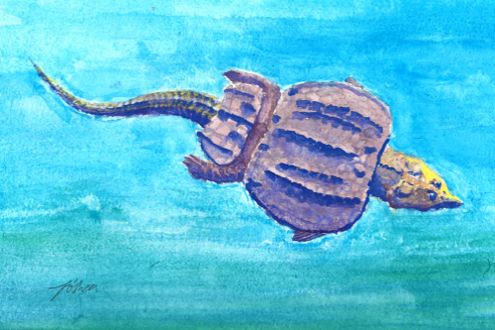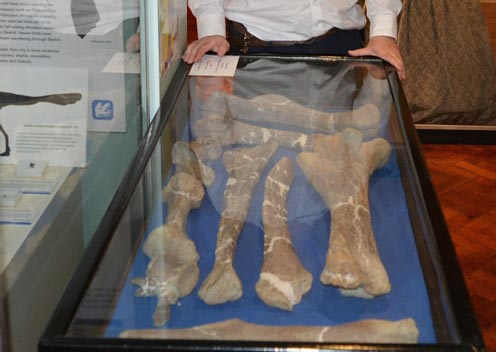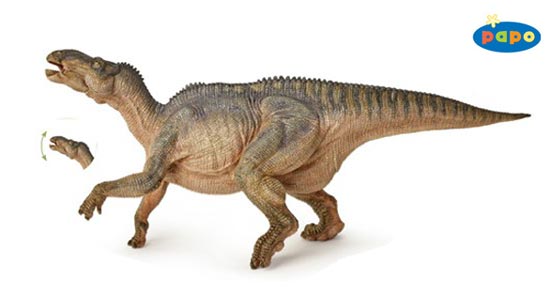Ancient Triassic Seas of South West England Teemed with Life
An ancient coastal landscape has been brought to life thanks to the dedicated research of an undergraduate from Bristol University. Klara Nordén has explored the diversity of animal life that inhabited the shorelines of south-western England 200 million years ago (Late Triassic), using fossils collected by Gloucester-based geologist Mike Curtis back in the 1980s.
Late Triassic Landscape
The student from the School of Earth Sciences (Bristol University) examined material from Late Triassic sediments at the Marston Road Quarry, near the town of Nunney in Somerset. This site is well known for its microfossils and many types of fossil teeth. Although Mike Curtis collected the material back in the 1980s the fossils have not been formally studied until now.
The paper published in the “Proceedings of the Geologists’ Association” highlights the diverse fauna that once existed in this part of south-western England. The palaeoenvironment consisted of a shallow, tropical sea with many small islands close by. It was on these islands that Bristol’s very own dinosaur the Thecodontosaurus roamed.
Triassic Fauna
Thecodontosaurus was the fourth dinosaur to be officially described (actually it was described before the term Dinosauria had been erected). Although a number of specimens were lost when Bristol City Museum was bombed in World War II, enough fossil material has been collected to make this little Sauropodomorpha one of Britain’s best known early Mesozoic dinosaurs.
To read an article about Thecodontosaurus: Bristol Remembers Thecodontosaurus.
The study revealed a total of six species of bony fish and a further six species of shark, as well as the presence of a placodont, a type of marine reptile believed to be distantly related to the plesiosaurs and a member of the Sauropterygia. The placodont has been identified as Psephoderma alpinum. Described as being lizard-like with an armoured shell, this reptile fed on shellfish and other invertebrates found in the sediment on the seabed.
Psephoderma alpinum
An Artist’s Drawing of the Placodont Psephoderma alpinum

An illustration of the Triassic placodont Psephoderma.
Picture credit: James O’Shea
Predatory Marine Reptiles
In addition, the study revealed the presence of a number of predatory marine reptiles including a crocodile-like animal in the shallow coastal waters (Pachystropheus rhaeticus), a semi-aquatic reptile first described in 1935, nearly one hundred years after the fossils of Thecodontosaurus were scientifically studied.
Commenting upon her research into this ancient Somerset archipelago, student Klara stated:
“We were excited to find teeth from a placodont, which are rare in British sediments. The presence of placodonts indicates that the area was once a coastal environment, with shallow waters and abundant invertebrate prey. Placodonts were in decline in the Late Triassic and the placodont teeth from Marston Road mush come from some of the last of these reptiles to exist on Earth.”
The strata in this part of the world associated with the Upper Triassic (Rhaetian faunal stage), is well-known for its bone beds containing abundant remains of fish and reptiles. It is not just marine fauna that has been preserved, fluvial processes have resulted in the long distance transport of the remains of land animals around at the time becoming deposited into the shallow marine strata being laid down.
The study also revealed the presence of sphenodontians that would have co-existed on the tropical islands alongside the dinosaurs.
Sphenodontians Alongside Dinosaurs
Sphenodontians inhabited the islands in the archipelago, which they shared with Thecodontosaurus, the famous ‘Bristol dinosaur’. These small animals resemble lizards but they are not members of the Order Squamata. They represent a very ancient reptilian lineage that probably originated in the Early Triassic. Like lizards and snakes, they are diapsids and the sphenodontians are classified along with snakes and lizards in the SuperOrder Lepidosauria but on a distinct branch from the Squamata, (the Rhynchocephalia – meaning “beak heads”). This study documents the first time that sphenodontian fossils have been recorded in British marine sediments.
Although once diverse, there is only one genus of Sphenodontian living today, the remarkable Tuatara that can be found on a few New Zealand islands (there are attempts being made to introduce this little reptile back to the New Zealand mainland).
To read an article about a genetic study into these ancient reptiles: The Tuatara Has a Surprise in its Genes.
The Triassic Fauna of a Coastal Landscape
Klara’s supervisor is Professor Michael Benton (School of Earth Sciences), he explained that the fossils reveal the details of a coastal landscape that existed some 200 million years ago and they paint a very different picture from today, after all, the Bristol Channel can hardly be regarded as a tropical sea.
The Professor stated:
“It’s really unusual to find remains of land-living animals mixed in with the marine fishes and sharks. They must have been washed off the land into the shallow sea and this provides evidence to match the age of the marine and terrestrial deposits in the area.”
Co-author of the report, published in the “Proceedings of the Geologist’s Association”, Dr Chris Duffin added:
“I began working on these fossils from the Bristol area forty years ago and it’s great to see such wonderful work by a Bristol undergraduate.”
For models and replicas of Triassic dinosaurs and other prehistoric animals: CollectA Age of Dinosaurs Models and Figures.





